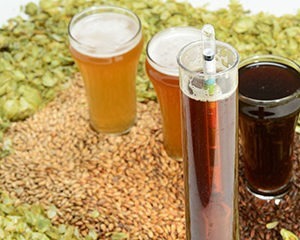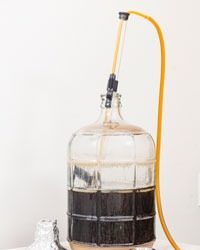When the Trub Breaks

Collectively we call it the trub, but generally the gunk that lands at the bottom of your brew kettle at the end of the day can be broken down into three distinct types: Hot break, cold break, and hop debris. Some brewers go to great lengths to try to remove as much trub as possible before fermentation starts, while others will have their beer on trub right up until packaging time. I’ll try to sort through some of the information on what trub is and when it may be helpful or when it could be detrimental to your beer.
So let me start out by describing the three trub types. First up is the hot break, which begins to form as the wort in the kettle heats up towards the boil. This often looks like the coagulated egg in egg drop soup in your boil kettle. Meanwhile the cold break forms after the boil as the wort goes through the chilling process. Both types of break are generally protein-based material that has fallen out of solution. The hop debris is the remaining vegetal matter from hops that were added during the brewing process.
Breaking It Down
The two forms of break are mainly malt-derived proteins that cluster together. There are some other non-protein compounds that can be found in the break, but the majority of the two forms of break are made up of protein, roughly 50% of hot break and 60% of cold break. According to an analysis done by the Siebel Institute, polyphenolic compounds make up a large portion of the cold break material as well while fatty acids can make up a decent portion of the hot break material. Clumps of break form because of portions of the long protein chains that are oil-loving (hydrophobic) cluster together. Other hydrophobic material, like fatty acids, will join in the mix as well.
Boilovers usually occur thanks to proteins. But as the proteins clump and the hot break develops very early in the boil, the break material becomes heavier and falls back into the wort instead of being lifted into suspension as foam. This is why boilovers generally are the biggest concern right as the boil commences. The pH of the wort does matter and stronger hot breaks occur with lower-pH worts. If you’re an all-grain brewer and not seeing good-sized hot break, your wort’s pH may be too high and a look at water chemistry may be in order. Some homebrewers will skim the dark-colored foam that forms early in the boil kettle’s foam process, but there is little evidence that supports that this removal improves the final beer.
Cold break forms as the wort is quickly chilled, shocking more proteins to break out of solution. This can often be aided by polyphenolic compounds from hops and finings, such as PVPP and tannic acid. Irish moss, aka carrageenan, also improves the formation of cold break. Cold break is often fairly nutrient-rich so many brewers may want to keep cold break in the fermenter for yeast health reasons. Some of the cold break may be reabsorbed into solution and contribute to chill haze later in the beer’s life, so some brewers may opt to dump the cold break. More on this in the next section.
Hop debris is something that many brewers want to leave behind in the kettle or container to keep the debris separate from the wort as it goes into the fermenter. Just as many brewers don’t want beer to be in contact with dry hops for an extended period of time, too much vegetative compounds can be detrimental to the final beer. Some brewers use hop filters, steel baskets, or hop spiders to make sure the hop debris remains in the kettle.
Trub Management
Trub volume is influenced by the amounts of trub “ingredients.” Things that tend to increase trub volume include increasing the wort’s original gravity, high protein ingredients (such as wheat), and high hopping rates. Since an increase in trub volume usually increases wort loss, brewers may want to focus on reducing trub volume. This can be accomplished by increasing the trub density. So how can you increase trub density? First is through the use of certain kettle finings, such as PVPP or similar products that promote settling. Second is by allowing a settling time. Reed Antis of the homebrew shop Saratoga Zymurgist suggests one hour of cold wort settling in the kettle prior to racking into the fermenter.
If a lot of trub is brought over into the fermenter, brewers can still perform trub management. Brewers with conical fermenters can dump the settled trub out of the bottom of the fermenter. Others may want to rack the wort off the trub into a second fermenter after settling. Another form of trub management is skimming the “Braun Hefe” or brown yeast that rises to the top of the kräusen during fermentation. If you do go to lengths to remove the wort from the trub, there is a reward and a risk. First, you are likely going to be lowering your fusel alcohol level and slightly increasing ester levels in the final beer. This is your reward as fusel alcohols are considered a fault and esters are often an asset. But if you do completely remove the trub, there is a risk. Without the fatty acids found in the trub, yeast health can suffer. Luckily for us, this can be offset by proper aeration of the wort. So don’t skip this step if you’re removing the trub. If you don’t have the means to properly aerate your wort, then leaving at least the cold break will be beneficial for the beer.


